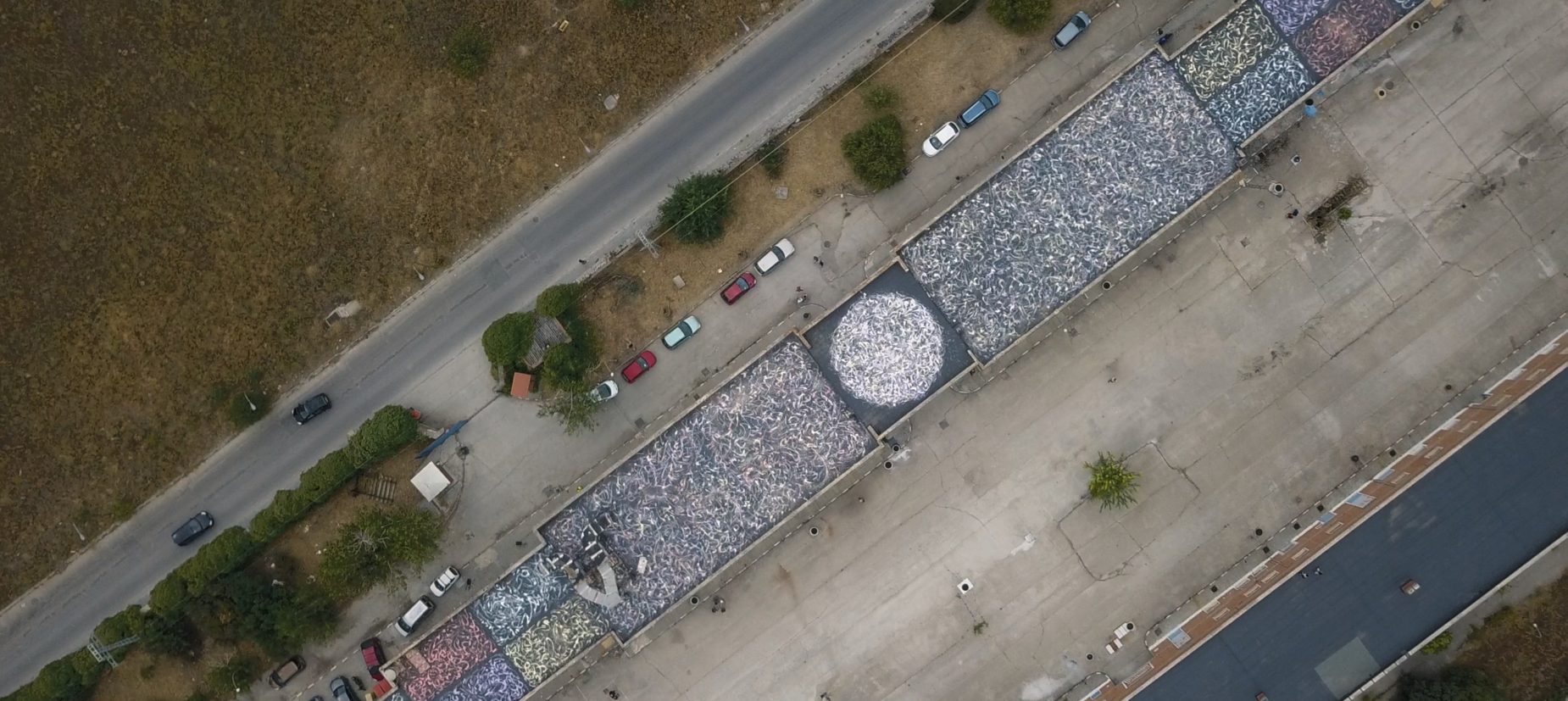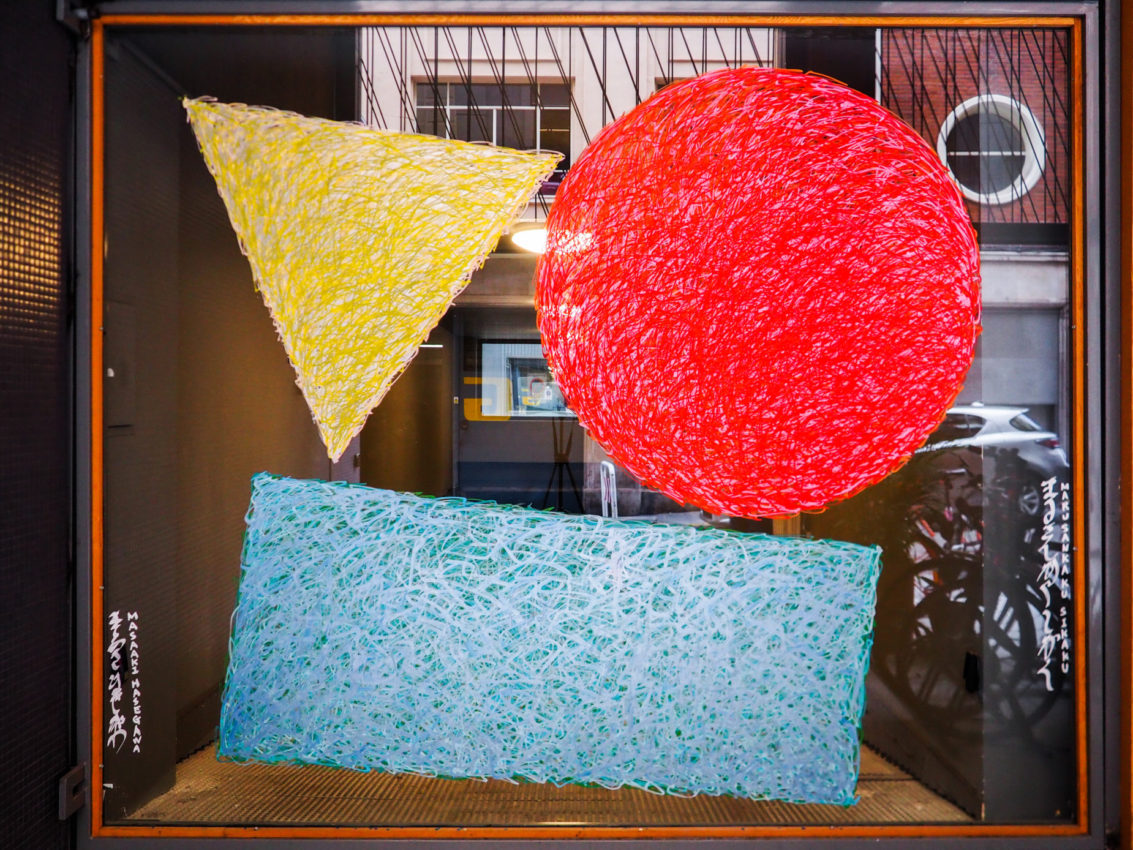Public Artworks
Artwork is made as a catalyst to connect spaces with the universe. It serves as a door to an unknown reality and makes the invisible visible.
This series aims to produce catalysts to connect people beyond borders such as nationality, language, generation, religion, and gender. Its prime purpose is the exploration of ways in which art can contribute to global society and partially solve global issues and problems, rather than focusing on its economic value and role in the marketplace.
This series challenges the idea that artworks are merely tradable merchandise and posits that its pure purpose can be of service to society.

This artwork is the biggest calligraphic artwork in Europe (1926 sq meters) and was created on the rooftop of the Zapadores Museum.
The artwork represents the transition from the chaotic and unorganized world to the organized but united world where people can respect others having different cultures and backgrounds.
The enormous size represents how it is important to open your mind and accept others to connect us beyond borders and realize a truly peaceful world.

From the COVID-19 pandemic, wildfires in Australia, and Typhoon Haishen to extreme heat in California, flooding in Jakarta, and the earthquake in Alaska, 2020 has been a year filled with natural disasters. We have been forced to re-think our relationship with nature and realize how vulnerable we are when confronted by Mother Nature. Though we have technology that allows us to live in such a comfortable and safe world, these natural disasters have shown us that humans have been overconfident in themselves. It is time for us to change the way we think about nature, from “how to control nature” to “how to live with nature.” For a long time, humans have thought that we are superior to other animals and living beings. Human-developed technology has led us to think that we are in a position to control nature. Just as it is important to listen to others in order to understand them better and develop better relationships, it is necessary to listen to what nature tells us. It is time for us to have a dialogue with nature.
This artwork consists of two colors: red and white, which represent the artist’s origin: Japan. Throughout Japan’s history, the fundamental philosophy of life has always been to “live with nature.” While the Western world’s focus has been on dominating nature, including the domestication of animals and overcoming natural limitations such as gravity, the Japanese approach has been co-living with nature. As it is globally known, Japan has had to deal with many kinds of natural disasters: typhoons, earthquakes, volcanoes, and tsunamis. So, Japan has cultivated a way of thinking about how to co-exist with nature, rather than controlling it. Therefore, the principal colors of the artwork represent the importance of communication with nature, rather than controlling nature. It is important to emphasize that this has nothing to do with nationalism, but is about bringing an Eastern philosophy on nature to the Western world in order to change the way we deal with nature.
From a contemporary art perspective, the value of this artwork is embedded in the context and environment of its creation. By placing the artwork in the middle of nowhere, far away from a city center, it creates a clear and strong contrast between nature and human development. By using a ready-made object—a container that has enabled humans to accelerate the transportation of goods such as livestock and commercial products—it raises a hairy question: “Is art truly meaningful or merely a manifestation of the human ego?” There is a premise in the art world that art is meaningful and valuable for humanity. However, if we change the perspective from human-centered to nature-centered, it is obvious that humans are just a small part of nature. So, there is a radical and fundamental question of whether human creation is truly meaningful and valuable to nature. For the audience, this artwork is a means to deliver a message to change the way we engage with nature. However, from the perspective of a practicing contemporary artist, this artwork serves to challenge the basic premise and consensus of art itself and generate a disruptive shift in the way we think about ourselves.

This artwork is the biggest calligraphic artwork in Europe (1926 sq meters) and was created on the rooftop of the Zapadores Museum.
The artwork represents the transition from the chaotic and unorganized world to the organized but united world where people can respect others having different cultures and backgrounds.
The enormous size represents how it is important to open your mind and accept others to connect us beyond borders and realize a truly peaceful world.
Maru (circle), Sankaku (Triangle), and Shikaku (Rectangle) are considered the essence of the universe in Buddhism in Japan.
This artwork was made inside a co-working space where many entrepreneurs and startup companies work.
Thus, this artwork represents the infinite possibilities that are out there in front of us.

This artwork (50m) was made at IE University, which has students from more than 100 countries.
The artwork represents that we are all different but live on the same planet.
It reveals the importance of cultivating a flexible mind in order to expose oneself to different values and cultures.